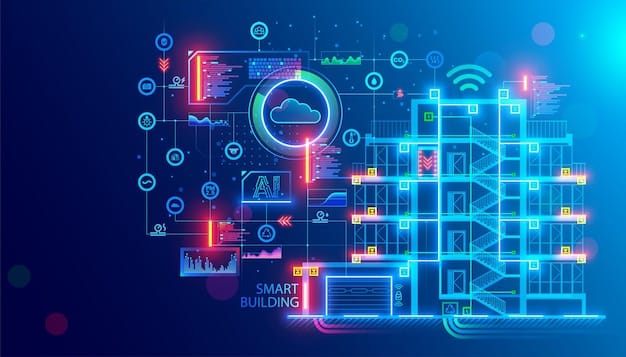IoT Evolution in US: Connecting Everything Securely

The Internet of Things (IoT) has rapidly transformed the US landscape, connecting diverse devices and systems to create an interconnected digital ecosystem, with a persistent focus on robust security measures to protect data and infrastructure.
In a world increasingly defined by digital interconnectedness, the evolution of IoT in the US: connecting everything securely stands as a testament to transformative technological progress. From smart homes to urban infrastructure, IoT is reshaping how we live, work, and interact with our environment, necessitating an unwavering focus on security from day one.
The Dawn of IoT: From Concept to Connectivity
The journey of the Internet of Things (IoT) in the United States began not with a bang, but with a gradual understanding of how everyday objects could become intelligent nodes in a vast network. Initially confined to industrial automation and niche applications, the concept of interconnected devices capable of data exchange slowly gained traction. Early pioneers envisioned a future where machines communicated seamlessly, optimizing processes and providing unprecedented insights.
The foundational elements were laid in the late 20th century, with the advent of pervasive computing and miniaturized sensors. However, it was the proliferation of powerful, cost-effective microcontrollers and widespread internet access that truly catalyzed IoT’s progression. This period saw the emergence of rudimentary smart devices, primarily focusing on convenience and remote monitoring.
The early 2000s marked a critical inflection point. As broadband availability expanded and manufacturing costs for embedded systems decreased, the potential for IoT moved beyond academic discourse into practical applications. Companies began experimenting with connected appliances and basic automation systems, setting the stage for the explosive growth that would follow. The focus, even then, was on utility, but the nascent security implications were beginning to surface, albeit in a limited capacity.
Early Adopters and Use Cases
- Industrial Automation: Manufacturing plants utilized sensors for predictive maintenance and operational efficiency.
- Smart Homes (Basic): Early adoption included remote control of lighting and thermostats.
- Logistics and Supply Chain: Tracking goods with RFID tags provided initial visibility.
This formative era was characterized by fragmented ecosystems and proprietary protocols. While exciting, the lack of standardization posed significant challenges, hindering large-scale deployment and interoperability. Yet, each successful pilot project, no matter how small, added to the growing conviction that a connected world was not just possible, but inevitable.
The early lessons learned about data collection, network reliability, and user interfaces laid crucial groundwork. Moreover, the inherent vulnerabilities of these connected systems started to become apparent. While the primary driver was convenience or efficiency, the industry slowly began to realize that true ubiquity depended not only on connectivity but also on trust and resilience.
In essence, the dawn of IoT in the US was a period of exploration and foundational build-out. It was an era where the technological building blocks were assembled, and the initial use cases demonstrated the immense, albeit nascent, potential of a truly connected environment. The stage was set for a more sophisticated and, critically, more secure, evolution.
The Mid-2010s: IoT Enters the Mainstream
By the mid-2010s, IoT was no longer a niche concept; it had firmly entered the mainstream consciousness in the United States. This era was characterized by a surge in consumer-facing smart devices and significant advancements in enterprise IoT solutions. The proliferation of smartphones, acting as control hubs, played a pivotal role in democratizing access to connected technologies. Devices like smart speakers, fitness trackers, and sophisticated home security systems became common household items.
For businesses, the applications diversified dramatically. Retailers adopted intelligent inventory management systems, healthcare leveraged wearable sensors for remote patient monitoring, and smart cities began experimenting with connected public infrastructure. The sheer volume of data generated by these devices grew exponentially, creating new opportunities for analytics and predictive insights.
However, this rapid expansion brought inherent challenges, particularly in the realm of security. Many early devices were designed with convenience and speed-to-market as primary concerns, often neglecting fundamental security principles. Default passwords, unpatched vulnerabilities, and insecure communication protocols became commonplace, creating significant attack vectors for malicious actors. Data privacy also emerged as a pressing concern as personal information circulated through vast, unregulated networks.
Key Drivers of Mainstream Adoption
- Increased Computing Power: Miniaturization and affordability of powerful processors.
- Cloud Computing: Scalable and cost-effective data storage and processing.
- Mobile Connectivity: Widespread smartphone adoption as IoT control centers.
- Developer Ecosystems: Growth of platforms and tools for IoT application development.
The Mirai botnet attack in 2016 served as a stark wake-up call, demonstrating the devastating potential of unsecured IoT devices when harnessed for distributed denial-of-service (DDoS) attacks. This incident highlighted the urgent need for a more robust security framework and spurred calls for industry-wide best practices and regulatory oversight.
Against this backdrop, the conversation around IoT security shifted from an afterthought to a critical priority. Manufacturers, pressured by consumers and potential regulatory action, began to incorporate more secure design principles into their products. Cybersecurity firms started offering specialized solutions for IoT ecosystems, recognizing the unique challenges posed by resource-constrained devices and heterogeneous networks.

The mid-2010s solidified IoT’s presence in American daily life and business operations. It was a period of immense innovation and adoption, but also one that underscored the paramount importance of security as connectivity became the norm. The lessons learned during this phase would profoundly influence the future direction of IoT development, pushing for a more secure and resilient interconnected landscape.
Establishing Security as a Core Pillar of IoT Development
By the late 2010s and early 2020s, the narrative around IoT in the US fundamentally shifted: security was no longer an optional add-on but an indispensable core pillar of development. The pervasive nature of IoT devices, from critical infrastructure to personal health monitors, necessitated robust safeguards against cyber threats. The move towards embedding security from the design phase, often referred to as “Security by Design,” gained significant traction.
This paradigm shift involved a multi-faceted approach. Manufacturers began to prioritize secure boot mechanisms, hardware-based root of trust, and robust encryption protocols for data in transit and at rest. Over-the-air (OTA) updates became standard, allowing for timely patching of vulnerabilities. Authentication mechanisms evolved beyond simple passwords, incorporating multi-factor authentication (MFA) and certificate-based identities.
Regulatory bodies and industry consortia also played a crucial role. The National Institute of Standards and Technology (NIST) published guidelines and frameworks, such as the IoT Cybersecurity Program, providing valuable standards for secure IoT development and deployment. State-level initiatives, like California’s IoT security law, mandated basic security requirements for connected devices sold within the state, signaling a growing legislative interest in consumer protection.
Key Security Measures Implemented
- Hardware-Based Security: Secure elements and trusted execution environments.
- Data Encryption: End-to-end encryption for sensitive data streams.
- Secure Updates: Verifiable firmware updates to prevent tampering.
- Identity Management: Unique device identities and robust authentication.
- Network Segmentation: Isolating IoT networks to contain potential breaches.
The focus extended beyond individual device security to encompassing the entire IoT ecosystem. This included securing communication protocols, cloud platforms used for data processing and storage, and the backend infrastructure managing device fleets. Zero Trust architectures, which assume no device or user can be trusted by default, began to be applied to IoT deployments, demanding stricter verification at every access point.
Furthermore, the cybersecurity talent pool specializing in IoT began to grow, addressing the unique skill sets required to identify and mitigate threats in resource-constrained environments. Ethical hacking and bug bounty programs specific to IoT devices became more common, encouraging manufacturers to proactively identify and fix vulnerabilities before they could be exploited.
This period represented a significant maturity leap for IoT in the US. The realization that widespread adoption and public trust were contingent upon stringent security measures led to substantial investments and innovations in cybersecurity. The journey was, and continues to be, ongoing, but the commitment to secure connectivity solidified as a non-negotiable imperative.
The Era of Edge Computing and AI Integration
The current phase of IoT evolution in the US is profoundly shaped by the integration of edge computing and artificial intelligence (AI). As the volume and velocity of data generated by connected devices continue to skyrocket, processing all of it in centralized cloud environments becomes increasingly impractical and inefficient. Edge computing emerged as a solution, pushing computation and data processing closer to the source of data generation—at the “edge” of the network.
This paradigm shift offers several critical advantages, including reduced latency, decreased bandwidth consumption, and enhanced privacy, as sensitive data can be processed and filtered locally before being potentially transmitted to the cloud. For IoT applications requiring real-time decision-making, such as autonomous vehicles, industrial control systems, and critical infrastructure monitoring, edge computing is absolutely transformative.
The synergy between edge computing and AI is particularly compelling. By embedding AI capabilities directly onto edge devices or local gateways, IoT systems can perform complex analytics, pattern recognition, and predictive modeling without constant reliance on cloud connectivity. This enables intelligent automation, proactive troubleshooting, and more nuanced responses in dynamic environments. For instance, an industrial sensor equipped with AI at the edge can analyze vibrations to predict machine failure with higher accuracy and act faster than if data had to travel to the cloud for analysis.

Benefits of Edge and AI Integration in IoT
- Real-time Insights: Faster decision-making for critical applications.
- Reduced Bandwidth: Less data transmitted to the cloud, saving costs.
- Enhanced Privacy: Sensitive data can be processed and anonymized locally.
- Improved Reliability: Less dependence on continuous cloud connectivity.
- Optimized Resource Use: Efficient use of distributed computing power.
Security challenges, however, evolve with this distributed architecture. Securing thousands or millions of edge devices, often in diverse and remote locations, requires robust device management, immutable identities, and decentralized security models. AI itself introduces new security considerations, such as the potential for adversarial attacks on machine learning models or the need to secure AI-generated insights.
The United States is at the forefront of this integration, with significant investments in edge infrastructure and AI research. Industries such as manufacturing, defense, and smart cities are heavily leveraging these advancements to create more resilient, efficient, and intelligent operations. The future of IoT is undeniably intertwined with these powerful computational and analytical paradigms.
The era of edge computing and AI integration signifies a pivotal moment in IoT’s maturation. It allows for more sophisticated, responsive, and autonomous connected systems, pushing the boundaries of what is possible. While bringing new security complexities, the benefits in performance, efficiency, and intelligence are driving widespread adoption and innovation across diverse sectors.
Cybersecurity Challenges and the Path Forward for Secure IoT in the US
Despite significant advancements, the cybersecurity landscape for IoT in the US remains complex and fraught with challenges. The sheer diversity of devices, protocols, and operating environments creates a vast attack surface. From resource-constrained sensors to powerful edge servers, each component presents unique vulnerabilities that malicious actors can exploit. Moreover, the long lifecycle of many industrial IoT devices means that legacy systems, often designed without adequate security, remain in operation for years, forming potential backdoors.
Supply chain security has emerged as a particularly critical concern. Ensuring the integrity of software, hardware, and components from manufacturing to deployment is a monumental task. A compromise at any point in the supply chain can introduce vulnerabilities that are difficult to detect and remediate once devices are in the field. This necessitates stricter vetting processes for suppliers and greater transparency across the entire product lifecycle.
Another persistent challenge is the lack of universal security standards and interoperability. While progress has been made, the fragmented nature of the IoT market often leads to siloed systems with varying levels of security maturity. This can create weak links in interconnected environments, allowing an attacker to penetrate one less-secure device and pivot to more critical systems. The absence of a national IoT security framework, while debated, continues to contribute to this patchwork landscape.
Key Cybersecurity Hurdles
- Device Diversity: Securing a vast array of devices with varying capabilities.
- Supply Chain Vulnerabilities: Risks introduced at any stage of manufacturing and delivery.
- Lack of Standardization: Inconsistent security practices across vendors and industries.
- Data Privacy Concerns: Managing and protecting personal and sensitive data.
- Firmware Updates: Ensuring timely and secure delivery of patches.
The path forward for secure IoT in the US involves a multi-pronged strategy. Enhanced regulatory guidance, potentially moving towards mandatory security standards for critical IoT sectors, is a likely development. Industry collaboration to develop and adopt open, secure protocols will be crucial for improving interoperability and reducing the attack surface. Furthermore, continuous security education for developers and users is paramount to foster a culture of secure IoT practices.
Investing in advanced threat detection and response capabilities, including AI-driven anomaly detection and behavioral analytics, will be essential for identifying and neutralizing sophisticated attacks. The evolution of quantum computing also presents a future challenge, necessitating research into quantum-resistant cryptographic algorithms for long-term data protection.
Ultimately, achieving truly secure and resilient IoT ecosystems in the US requires a sustained commitment from all stakeholders—manufacturers, service providers, policymakers, and consumers. It’s a continuous arms race against evolving threats, where vigilance, innovation, and collaboration are the strongest defenses.
Regulatory Landscape and Future Outlook for IoT in the US
The regulatory landscape for IoT in the United States is characterized by a mix of federal and state-level initiatives, reflecting a growing recognition of the need for oversight without stifling innovation. While a comprehensive federal IoT security law is yet to be established, agencies like NIST have provided significant guidance, and sector-specific regulations, particularly in healthcare (HIPAA) and critical infrastructure, indirectly impact IoT deployments.
At the state level, California’s IoT security law (SB-327), enacted in 2020, was pioneering. It mandated that device manufacturers implement “reasonable security features” appropriate to the nature and function of the device, preventing unauthorized access, modification, or disclosure of information. While broad, it signaled a clear intent to hold manufacturers accountable for basic security hygiene. Other states have considered similar legislation, pointing towards a potential trend for baseline security requirements across the US.
The Federal Trade Commission (FTC) has also been active, bringing enforcement actions against companies for deceptive practices related to IoT security and privacy. Their focus is often on ensuring that companies live up to their assurances about data protection and device security, pushing for greater transparency and accountability from manufacturers.
Potential Regulatory Avenues
- Interagency Coordination: Streamlining efforts across federal agencies.
- National IoT Security Standards: Developing mandatory baseline requirements.
- Data Privacy Frameworks: Comprehensive laws addressing data collection and usage.
- Software Bill of Materials (SBOM): Mandating transparency in software components.
Looking ahead, the future outlook for IoT in the US is one of continued growth, but with an increasingly strong emphasis on cybersecurity and resilience. We can anticipate more sophisticated government guidance, potentially leading to a national IoT cybersecurity framework or broader federal legislation that establishes common security baselines. The focus will likely shift from merely securing devices to securing entire interconnected systems, including the data flows, cloud platforms, and supply chains.
The rise of 5G and future wireless technologies will further fuel IoT expansion, enabling new applications that demand ultra-low latency and massive connectivity. This will, in turn, necessitate even more robust security measures to protect these high-stakes environments. Furthermore, ethical considerations surrounding AI and IoT, particularly in areas like surveillance and autonomous decision-making, will likely become a more prominent area of public debate and potential regulatory scrutiny.
The US is poised to remain a global leader in IoT innovation. However, this leadership will increasingly depend on its ability to build out truly secure and trustworthy IoT ecosystems. The evolving regulatory landscape, coupled with industry-led initiatives, will be instrumental in shaping a future where connectivity is synonymous with confidence.
Societal Impact and Ethical Considerations of Pervasive IoT
The pervasive nature of IoT in the United States extends far beyond mere technological novelty, profoundly impacting society and raising a host of ethical considerations. While the conveniences of smart homes, connected health, and intelligent cities are undeniable, the ubiquity of sensors and data collection mechanisms brings forth questions about privacy, autonomy, and the equitable distribution of technological benefits.
The sheer volume of personal data collected by IoT devices—from health metrics and location data to behavioral patterns within homes—raises significant privacy concerns. How this data is stored, shared, and utilized by companies and governments becomes a central ethical dilemma. Without strong regulatory frameworks and transparent data practices, individuals may lose control over their digital footprint, leading to potential misuse or exploitation of sensitive information.
Furthermore, the increased automation and decision-making capabilities of AI-powered IoT systems bring forth questions of autonomy. To what extent should machines make decisions that directly impact human lives, such as in autonomous vehicles or predictive policing? Ensuring human oversight and accountability in these systems is crucial to prevent unintended biases or errors from causing harm. The potential for job displacement due to automation also warrants careful consideration and proactive policy responses.
Ethical Considerations for IoT
- Data Privacy: Protecting personal information from unauthorized access and use.
- Bias in AI: Ensuring algorithms in IoT devices do not perpetuate or amplify societal biases.
- Autonomy and Control: Balancing human agency with automated decision-making.
- Digital Divide: Preventing a widening gap between those who benefit from IoT and those who do not.
- Surveillance: Addressing concerns about pervasive monitoring and its impact on civil liberties.
The societal impact of IoT also includes the risk of exacerbating the digital divide. While advanced IoT solutions bring significant advantages, their cost and the infrastructural requirements might limit access for lower-income communities or rural areas, creating an imbalance in access to modern conveniences, healthcare, and educational tools. Ensuring equitable access to these technologies is an important ethical imperative for policymakers and innovators.
The concept of digital surveillance, whether by commercial entities for targeted advertising or by governmental bodies for security purposes, is another area of intense ethical debate. The ability to track movements, conversations, and health status in unprecedented detail challenges traditional notions of anonymity and personal space. Striking a balance between security, convenience, and fundamental civil liberties is a delicate but necessary act.
As IoT continues to integrate into the fabric of American society, ongoing dialogue and robust ethical frameworks will be essential. This includes developing clear guidelines for data governance, ensuring transparency in algorithmic decision-making, and fostering public education about the capabilities and implications of connected technologies. Ultimately, the successful and ethical evolution of IoT in the US will depend on our ability to harness its potential responsibly, prioritizing human values and societal well-being above all else.
| Key Point | Brief Description |
|---|---|
| 🚀 Mainstream Adoption | IoT moved into daily life and business, driven by smart devices and cloud. |
| 🔒 Security Focus | Security became a core element, emphasized by “Security by Design” and regulations. |
| 🧠 Edge & AI Integration | Processing data closer to source with AI for real-time insights and efficiency. |
| 🌐 Ethical Concerns | Addressing privacy, autonomy, and the digital divide as IoT expands. |
Frequently Asked Questions About IoT Evolution in the US
▼
Key drivers include advancements in sensor technology and AI, widespread 5G connectivity, and the increasing demand for automation and data-driven insights across various sectors. Consumer adoption of smart home devices and industrial demand for operational efficiency also propel growth.
▼
Early IoT security was often an afterthought, but major incidents like the Mirai botnet attack spurred a shift towards “Security by Design.” Now, manufacturers prioritize encryption, secure boot, and regular firmware updates, with increasing regulatory and industry pressure for robust safeguards.
▼
Edge computing processes data closer to its source, reducing latency and bandwidth use, crucial for real-time IoT applications. It enables faster decision-making, enhanced privacy by local processing, and improved reliability, especially when combined with AI for on-device analytics.
▼
While a single comprehensive federal law is absent, states like California have enacted IoT security laws requiring “reasonable security features.” Federal agencies like NIST offer guidelines, and sector-specific regulations, such as HIPAA for healthcare IoT, impose strict data protection requirements.
▼
Primary ethical concerns revolve around data privacy, the potential for algorithmic bias in AI-driven IoT, questions of human autonomy versus automated decision-making, the risk of widening the digital divide, and the overarching implications of pervasive surveillance.
Conclusion
The evolution of IoT in the US from fragmented concepts to a ubiquitous, interconnected ecosystem highlights a remarkable journey of innovation and adaptation. While the benefits of efficiency, convenience, and profound insights are undeniable, the path forward is inextricably linked with robust cybersecurity measures. The continuous commitment to securing devices, platforms, and data, coupled with a thoughtful approach to regulatory frameworks and ethical considerations, will define the success and trustworthiness of a truly connected America. As we continue to connect everything, ensuring that connectivity is both smart and secure remains the paramount objective.





